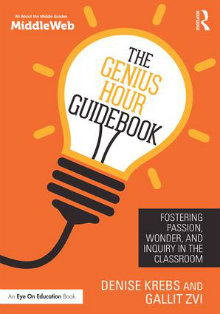Guiding Student Passion, Wonder & Inquiry
The Genius Hour Guidebook: Fostering Passion, Wonder, and Inquiry in the Classroom
By Denise Krebs and Gallit Zvi
(Routledge/MiddleWeb, 2016 – Learn more)

In The Genius Hour Guidebook, Denise Krebs and Gallit Zvi present compelling reasons for implementing Genius Hour in our classrooms – and step-by-step ideas on how to do it.

In addition, Genius Hour embeds a number of core standards, as well as higher order and 21st Century skills, into the daily routine of the classroom. Students learn to self-assess, problem-solve, think critically, communicate, collaborate and master literacy skills (reading, writing, presenting, listening and digital citizenship).
Genius Hour allows us to give students authentic opportunities to create and contribute to the world and prepare themselves for a future in our ever-changing world.
Resources for implementation
The book is full of resources, planning tools and advice based on experience. There’s a companion website (that’s open to anyone) where you’ll find materials discussed in the book and articles that expand on the book’s core content (see for example 5 Genius Hour Strategies to Get You Started).
Chapters cover topics starting with what Genius Hour is, followed by step-by-step guidelines to introduce it to your class, launch your program, coach students as they select topics, share ownership of the classroom, help students make their learning visible, teach students how to self-assess and give and receive constructive feedback, and spark their thinking about projects that can improve their world.
Each chapter has boxes with Teacher Tips to help implementation go more smoothly. There are sample non-Google-able questions and possible scaffolding steps if needed. Zvi and Krebs also describe how they embed the many skills that will prepare our students for the future, and how to prepare them for, and allow them to have, more ownership and control during non-genius hour time in the classroom.
The book concludes with appendices including an FAQ section addressing questions and pushback that teachers wanting to implement Genius Hour might encounter. The authors also share some sample lesson plans and a helpful reading list.
Forward-looking learning
The authors make many very sound points as they describe methods we can use to change our teaching and student learning in innovative ways, using Genius Hour as the vehicle. They quote Alvin Toffler, the visionary author of Future Shock (1970): “The illiterate of the 21st century will not be those who cannot read and write, but those who cannot learn, unlearn and relearn.” Ultimately, they say, a good education “isn’t about what the teacher does; it’s about what the child learns” (p. 78).
This book provides compelling reasons to dedicate the time necessary for learners to have free rein – reasons we can share with naysayers – and clear steps to make the time successful. It’s definitely worth the read for anyone wanting to change the way the education game is played.
Dr. Laura Von Staden is a Middle School Special Education Lead Teacher in Tampa, Florida. She serves on numerous committees at the school and district level and works closely with the local university where she is a Professional Practice Partner and a master mentor, conducts action research and facilitates Professional Development.

































